外研版七年级英语上册教案:Unit1
- 格式:docx
- 大小:30.61 KB
- 文档页数:3


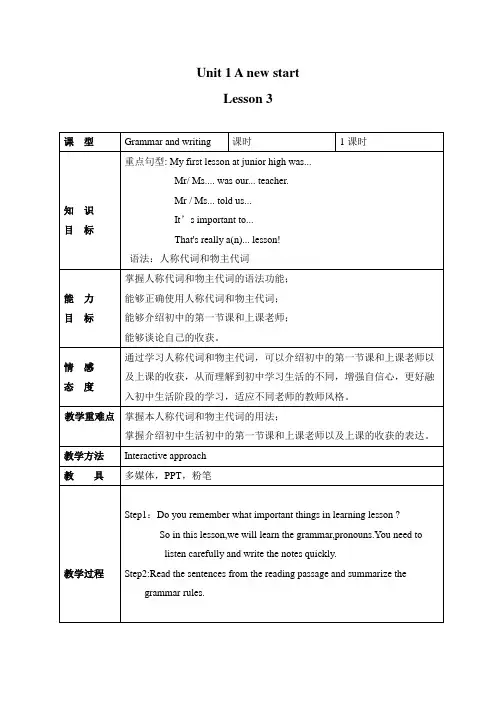

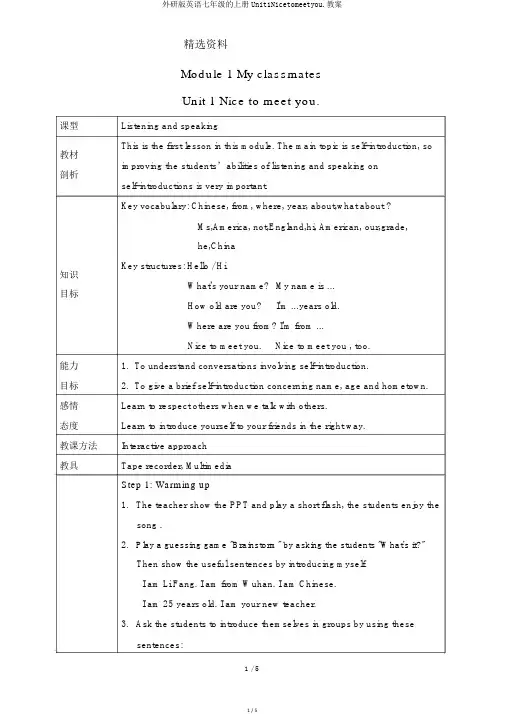
精选资料Module 1 My classmatesUnit 1 Nice to meet you.课型Listening and speakingThis is the first lesson in this module. The main topic is self-introduction, so 教材improving the students’abilities of listening and speaking on剖析self-introductions is very important.Key vocabulary: Chinese, from, where, year, about,what about ?Ms,America, not,England,hi, American, our,grade,he,ChinaKey structures: Hello / Hi知识What's your name? My name is ...目标How old are you? I'm ...years old.Where are you from? I'm from ...Nice to meet you. Nice to meet you , too.能力 1. To understand conversations involving self-introduction.目标 2. To give a brief self-introduction concerning name, age and hometown.感情Learn to respect others when we talk with others.态度Learn to introduce yourself to your friends in the right way.教课方法Interactive approach教具Tape recorder, MultimediaStep 1: Warming up1. The teacher show the PPT and play a short flash, the students enjoy thesong .2.Play a guessing game "Brainstorm" by asking the students "What's it?"Then show the useful sentences by introducing myself.I am Li Fang. I am from Wuhan. I am Chinese.I am 25 years old. I am your new teacher.3. Ask the students to introduce themselves in groups by using thesesentences:教课过程教课过程精选资料What's your name? Where are you from?How old are you?Which class are you in?Nice to meet you.Step 2: Listening1.Play the recording in activity 1 and ask the students to listen andcheck how many people speak.2.Play it again and ask the students to check the words their hear.3.Check the answers with the whole students.Step 3: Listen and read1.Play the recording in activity 3 and ask the students tolisten and answer the questions. Then check the answers.(1)How many people speak in the conversation?(2)Who are they?(3)Are they in the same class?2.Play it again and check the true sentences in act3. Asksome students to correct the wrong ones.3.Put the students into groups of four to practise the dialogue. The students repeat it several times, changing roles each time.4.Talk about the pictures in the PPT and show their performances.5.Ask the students to sum up the useful sentences in the dialogueand introduce “ Everyday English. ”6.Finish act 4 and 5 in groups. Teacher checks the answers.Step 4: Pronunciation1.Explain that this activity focuses on some English phonemes whichare difficult to pronounce for speakers of Chinese.2.Play the recording once without stopping.3.Play it again and ask the students to repeat.4.Practise the sounds in pairs, then finish the exercises on the PPT.Step 5: Speaking1.Talk about the pictures by asking and answer in paris like this:A: What ’s his name?B: His name is .A: Where is he from?B: He's from .A:How old is he?B:He's ...years old.Step 6: Module taskTask 1: Who has the most friends?运用本课句型,在规定的八分钟时间内,以小组为单位,看谁结交的朋友最多,她将获取一份丰厚的奖品。

新外研版七年级英语上册教案Module 1 My classmates一、教学内容:Unit 1 Nice to meet you二、课型:Listening and speaking三、教学目标:知识与技能:1、能运用动词“be”的一般现在时的陈述和一般疑问形式。
2、能运用代词I,my,you,your,he,his,she,her。
3、能听懂别人的自我介绍。
4、能利用“be”动词作简单的自我介绍或询问对方个人信息。
情感态度与价值观:1、掌握在作自我介绍时英美人士和中国人的不同对答习惯。
2、培养良好的人际交流态度,交流时要尊重对方的习惯,令对方感到舒服。
四、教学重难点:重点:1、掌握基本词汇:Chinese, from, where, year, about, Ms, not, hi, our, American, he, China,What about, America, England。
2、动词“be”的一般现在时的陈述和一般疑问形式。
3、自我介绍的表达方式。
难点:1、能运用“be”的一般现在时的陈述和一般疑问形式。
2、能听懂别人的自我介绍。
3、能利用“be”动词作简单的自我介绍或询问对方个人信息。
五、教学准备:本次课堂为听说课,主要采用互动式教学法,创设真实语境,通过个人呈现,同伴互动,小组活动等师生、生生的交流,充分体现了学生在学习过程中的主体地位,教师只是课堂的引导者,组织者和合作者,让学生在使用中学会英语,综合培养学生的英语语言运用能力。
在教学过程中,采用多媒体手段辅助教学,利用各种图片和习题任务贯穿整个教学过程。
因此,本节课需准备:PPT课件、录音机、课堂练习、奖品。
教学步骤教师活动学生活动设计意图Step One Warming-u p (5’)Activity 1. Greet the studentsas usual.T: I’m very glad to be here andgive you a lesson. Just now, you arepuzzled about my name. Now let metry to introduce myself.“My name is Ms Mo. I’m ateacher. I’m from China and I’m1、Greet the teacher.用自己的图片吸引学生的兴趣,做出自我介绍,引出话题,以及重点句型。
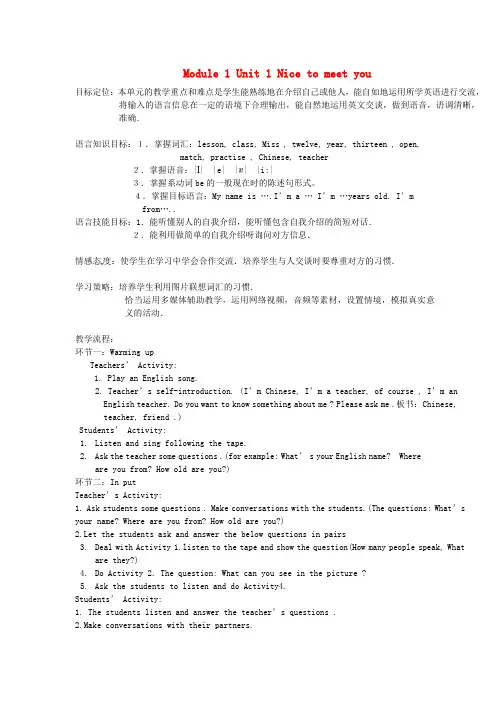
Module 1 Unit 1 Nice to meet you目标定位:本单元的教学重点和难点是学生能熟练地在介绍自己或他人,能自如地运用所学英语进行交流,将输入的语言信息在一定的语境下合理输出,能自然地运用英文交谈,做到语音,语调清晰,准确.语言知识目标:1.掌握词汇:lesson, class, Miss , twelve, year, thirteen , open,match, practise , Chinese, teacher2.掌握语音:|І| |e| |æ||i:|3.掌握系动词be的一般现在时的陈述句形式。
4.掌握目标语言:My name is ….I’m a … I’m …years old. I’mfrom…..语言技能目标:1.能听懂别人的自我介绍,能听懂包含自我介绍的简短对话.2.能利用做简单的自我介绍呀询问对方信息.情感态度:使学生在学习中学会合作交流.培养学生与人交谈时要尊重对方的习惯.学习策略:培养学生利用图片联想词汇的习惯.恰当运用多媒体辅助教学,运用网络视频,音频等素材,设置情境,模拟真实意义的活动.教学流程:环节一:Warming upTeachers’ Activity:1. Play an English song.2. Teacher’s self-introduction. (I’m Chinese, I’m a teacher, of course , I’m anEnglish teacher. Do you want to know something about me ? Please ask me .板书:Chinese,teacher, friend .)Students’ Activity:1.Listen and sing following the tape.2.Ask the teacher some questions .(for example: What’s your English name? Whereare you from? How old are you?)环节二:In putTeacher’s Activity:1. Ask students some questions . Make conversations with the students.(The questions: What’s your name? Where are you from? How old are you?)2.Let the students ask and answer the below questions in pairs3.Deal with Activity 1.listen to the tape and show the question(How many people speak, Whatare they?)4.Do Activity 2. The question: What can you see in the picture ?5.Ask the students to listen and do Activity4.Students’ Activity:1. The students listen and answer the teacher’s questions .2.Make conversations with their partners.3.Show the conversations.4.Listen to the tape and do Activity 1,answer the question.5.Describe the picture of Activity2.(引导学生尽量用所给的单词描述。
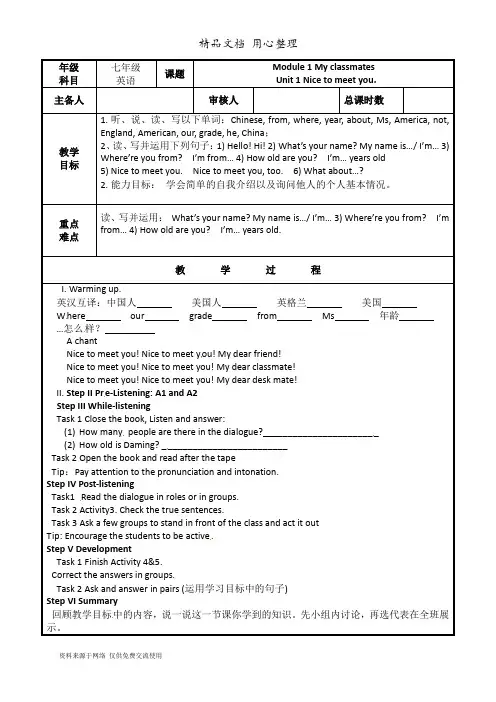

Unit 1 A new start单元教学目标单元教材分析本单元的话题是“人与自我”下的“生活与学习”,归属于“多彩、安全、有意义的学校生活”这个主题。
本单元内容围绕探索初中学校生活展开,主要包括:描述开学第一天不同国家人们的行为;介绍开学第一课;谈论关于初中学校生活的计划;描述对初中生活的理解。
旨在让学生更好地适应初中生活。
课时分解第一课时Starting out&ReadingTeaching Objects【教学目标】1.Discuss the customs of the first school day in different countries.2. Understand a famous saying about learning.3. Talk about the first lesson in junior high.Teaching Aids【教学工具】an English book,a tape recorder and CAITeaching Steps【教学步骤】★Step 1Lead in【导入】T: September 1st is the first day of school in China. Most schools have special activities to celebrate this day. What activities do the schools have?Ss:For example, have the school opening ceremony, have the flag-raising ceremony, watch the program The First Lesson produced by CCTV, have some welcome performances.Starting outPage 15,11.Ask the Ss to discuss the question: What do people do on the first day of school inRussia/ Indonesia/ France/ the USA?2.Show the four sentences on page 15 to the Ss and make sure they understand the meaning of these sentences.3.Ask the Ss to guess and match the sentences with the countries.4.Check the answers with the class.Page 15,21.Ask the Ss to answer the question: What is junior high school life like?2.Let the Ss list something about what junior high school life is like.3.Ask the Ss to complete the table.Understanding ideas(1-4)★Step 2 Pre-task【准备任务】Page 16,11.Show the questionnaire to the Ss.2.Ask the Ss to answer the following questions.①What was your first lesson at junior high?②What did you do in that lesson?③What do you think is important in learning the lesson?3.Let the Ss complete the questionnaire.Page 16,2Ask the Ss to look at the picture and the title, and then ask them to discuss the following questions.①What was the writer’s first lesson at junior high?②What did the writer do in that lesson?★Step 3 While-task【过程任务】Page 16,21.Let the Ss read the passage and answer the question: What did the writer do in his first lesson?2.Ask some students to say their answers.3.Check the answers with the class.Page 18,31.Ask the Ss to read the passage again and choose the main idea of the passage.2.Check the right answer with the class.3.Tell the way to summarize the main idea of a passage.Page 18,41.Let the Ss complete the summary with the words and expressions from the passage.2.Ask some students to say their answers.3.Check the answers with the class.★Step 4 Post-task【后续任务】Page 18,Think and share1.Ask the Ss to think about the following question.What is the meaning of the sentence from Confucius?2.Give the Ss some prompts. For example, Who did Confucius say the sentenceto? Why did he say it? What do you think about learning and thinking?3.Choose some Ss to share their answers.4.Ask the Ss to think about the following question:Do you know other famous sayings about learning?5.Let some students share their answers.6.Make appropriate supplements according to students’ share.For example, thinking without studying is useless;Reading without understanding is like chewing bark;Skill comes from diligent practice, and neglect results come from idleness;A journey of a thousand miles begins with a single step.★Step 5Language points【语言要点】1. mistake的用法mistake 作名词,意为“错误;失误”。
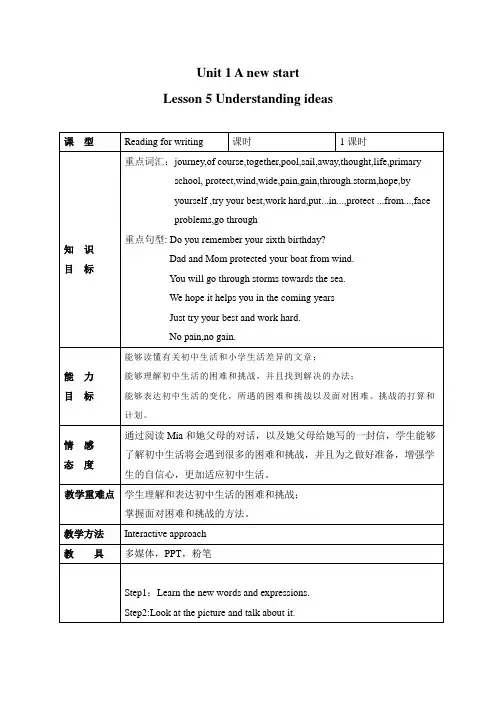
Unit 1 A new start Lesson 5 Understanding ideas教学过程教学过程How many people are there in the picture? Who are they?What do the parents give the girl?Step3:What can you do with a boat?Look at the picture,talk about what we meet.Look at the word and expressions and look up their meanings in adictionary.Studying at junior high is a journey.Let’s explore it.Step4:Reading the conversation and find out the meaning of the title.What is “journey”?What is the meaning of the title?Step5:Reading the conversation and answer these questions.( 1 ) What is their letter for?(2 )Is it the first paper boat from her parents?( 3 ) Did she remember (to have an idea ofsomething in one's mind) the first paper boat?( 4)What did they do with the first paperboat?Step6:Before reading the passage ,look at the timeline.Now,read the passage and complete the timeline.Step7:Complete the thinking map with the words and expressions from the passage.Step8:Answer the questions.1.What do “a pool”,”a river”and “the sea”stand for?2.What do you think Mia’s parents did protect her boat from wind?。
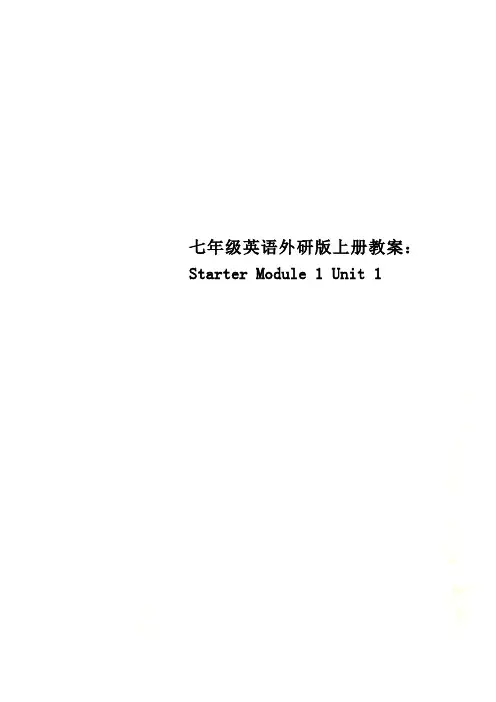
七年级英语外研版上册教案:Starter Module 1 Unit 1Module 1My teacher and my friendsUnit 1Good morning,Miss Zhou.Ⅰ.Teaching modelTeam-work and communication approachⅡ.Teaching aims1.To learn and understand the topic words through listening and reading2.To know something about letters and greetings3.To understand present simple “be”Ⅲ.Teaching aidsTape recorder,some cardsⅣ.Teaching stepsStep 1:Warming-up1.Introduce the teacher first with following sentence structures:(1)Hello/Good morning/Good afternoon(2)My name is…(3)My English name is…2.Ask students to introduce themselves in groups.Step 2:Listening and reading1.Play the tape and ask students to listen to the conversation in Activity 1 carefully.2.Ask students to read the conversations by themselves and underline the key words and sentences.3.Explain some difficulties to them.4.Work in pairs,act out the conversation.Step 3:Practice1.Read the sentences in Activity 3 and then match them.2.Listen and check them.Keys:1-b,2-c,3-d,4-a3.Read the conversation in Activity 4,then practice it in pairs.Step 4:Listening and writing1.Ask students to read the letters in Activity listen and say.2.Let students read the songs in Activity listen and sing.3.Read the letters in Activity write down the letters.4.Listen to the names in Activity 8.5.Listen again and then write down the names.6.Work in pairs and check the answers.Step 5:Homework1.Learn the new words by heart.2.Act out the conversation in groups.3.Finish off the workbook exercises.Blackboard DesignUnit 1Good morning,Miss Zhou.1.My name's Miss Zhou.2.Good morning,Miss Zhou. 3.Good afternoon,class.。
外研版英语七年级上册Module1 Unit One Nice to meet you 教学设外研版英语七年级上册module1unitonenicetomeetyou教学设外语教学与研究出版社,新标准,英语七年级,第一卷,教学设计moduleonemyclassmatesunitonenicetomeetyou一、教科书分析本模块以自我介绍为话题。
本节课是这个模块的第一课时,是一节听说课型的新授课。
这是学生进入初中的第一课,是教师向学生做自我介绍和教学生做自我介绍及相互问候的最佳时机。
本课学生的听说活动都是围绕初次见面是如何作自我介绍而展开。
学生们通过学习对话,了解如何做自我介绍。
本单元重在教会孩子通过自我介绍而与陌生人进行沟通,从而打开交流的僵局。
二、教学目标1.语言知识目标(1)目标句型:你好,我的名字,be,小姐,早上好/午后。
早上好下午好。
再见你是…人吗…?离…远吗…?2.技能目标(1)能够正确使用be动词,并且运用所学的句型作自我介绍。
(2)能够听懂,读懂,理解和复述整个对话。
(3)同学能通过有目的的听而提取有用信息。
(4)一些学生可以根据自己的实际情况调整对话内容并表演。
3.学习策略目标(1)利用多媒体,直观地展示单词和句型,并带领学生一起朗读。
(2)通过小组合作的方式,学会合作学习。
4.情感与态度目标在教学过程中,学生通过对话向他人介绍自己。
在相互介绍自己的过程中,学生们迅速地相互熟悉,感受到新集体的温暖,体验与同学合作的乐趣。
5.教学重点和难点用英语介绍进行简单的问候,并介绍自己的姓名,年龄,来自于哪里。
6.教具准备Ppt课件,课堂试题。
三、教学设计这门课是一门听说课。
在整个教学设计中,教师尽最大努力创造能启发学生思维的情境,引导学生在真实情境中学习和应用新知识。
你好,自我介绍,对话阅读,即兴表演。
这些活动使学生在应用中掌握新句子,实现语言知识向语言交际工具的转化。
初一新学期的学生需要对小学所学知识进行整理并在课堂上加以运用。
秋季学期外研版初中七年级英语上册教案全册Module1Myclamate(共5课时)Unit1Nicetomeetyou(2课时)Ⅰ.Teachinggoal(教学目标)1.能够听懂、读懂关于自我介绍的对话。
2.能够运用所学动词be的基本句型进行简单的自我介绍。
Ⅱ.Teachingdifficultie(教学重难点)重点:掌握本单元的基本词汇和句型,正确运用be动词的各种形式造句。
难点:能够用英语进行自我介绍。
Ⅲ.Teachingaid:(教学辅助)PPT课件第1课时(Activity1—3)ⅣTeachingcontent(教学内容)Ⅴ.Teachingprocedure:(教学过程)Step1.Warming-up播放英文歌曲或视频“Dayoftheweek”来活跃课堂气氛,同时为接下来的教学内容作好准备。
当学生能熟练地唱出这首歌时,英语教学就变得容易多了。
Step2Liteningandreading1.Litenandread.(Activity1)①教师播放录音,让学生整体感知对话内容。
②教师再次播放录音,学生跟—1—读、模仿。
③学生两人一组练习对话。
④教师让不同的小组展示对话,关注学生的发音。
2.Litenandrepeat.Nowpoint,akandanwer.(Activity2)①教师放录音,学生听录音。
②教师再次播放录音,学生跟读、模仿。
③学生两人一组根据日历练习对话。
④教师让部分小组展示对话。
环节说明:本活动以日历的形式让学生学习表示星期一至星期日的7个词汇,然后指着日历上的具体日期来询问星期几,进而练习相关句型“Whatdayiittoday”教师向学生说明在西方国家Sundayithefirtdayoftheweek,让学生了解这种文化差异。
Step3Practice1.Readandmatch.Nowlitenandcheck.(Activity3)①学生个体活动,完成匹配。
Unit 1 Is this your mum?环节1 新课导入教师展示一张照片并用英语介绍:S1: Is this your family?T: Yes,it is.S1:It's a big family!T:This is my parents.This is my son and that is my daughter.S2:Is this your mom?T:No,that is my aunt.设计意图:以问答的形式进行教学,旨在激活学生的背景知识,引出模块的中心话题,起导入话题和展示词汇的作用,为后面的学习打基础。
环节21. 教师领读方框中的单词。
2. 询问学生有哪些单词不认识,确保学生认识方框中的所有单词。
3. 学生两人小组活动,谈论托尼的家庭成员。
4. 教师请一到两个小组在课堂上展示。
5. 教师讲明活动2要求,让学生个体活动,然后全班核对。
6. 让学生听录音,让学生跟读。
7. 听录音,选择正确答案。
8. 核对答案。
9. 解释一些词及短语。
10. 分角色朗读对话。
11. 学生个体活动,听录音,选出正确的单词,完成短文。
12. 两人一组核对答案,然后全班核对答案。
13. 本活动可以先让学生朗读,然后教师就学生的错误之处进行纠正,最后听录音再读一遍。
14. 完成本活动后,可以做一些有针对性的语音练习,继续巩固这3个音及含有这3个音的单词。
15. 两人一组,向对方展示自己的全家福,用活动中的句式进行问答。
16. 学以致用。
(根据句意及汉语意思完成下面的句子,一空一词)(1)吉姆在我的前面。
Jim is in front of me.(2)在简旁边的那个男孩是谁?Who is the boy next to Jane?(3)杰克在照片的右边。
Jack is on the right (右边)in the photo.设计意图:本节课活动旨在向学生展示目标词汇,同时通过说的练习让学生充分熟悉本模块的重点词汇。
课题外研版七年级上册Unit 1 A New Start Developing Ideas 讲义一、教学目标1. 知识目标学生能够听懂与学校生活和学习计划相关的听力材料。
掌握并运用与学习计划和问题相关的词汇和句型。
2. 技能目标通过听力练习,提高学生获取关键信息和细节的能力。
能够运用所学语言,就学习计划中的问题进行交流并给出建议。
培养学生合作学习和沟通的能力。
3. 情感目标激发学生对新学习生活的积极态度和热情。
增强学生解决学习中问题的信心和能力。
二、教学重难点1. 教学重点掌握重点词汇,如:schedule, challenge, solution 等。
理解并准确获取听力材料中的关键信息。
能够运用所学句型就学习计划的问题进行交流和建议。
2. 教学难点对较复杂的听力内容的理解和把握。
如何引导学生用恰当的语言和逻辑给出有效的学习计划建议。
三、教学方法1. 任务型教学法:通过布置各种任务,让学生在完成任务的过程中学习和运用语言。
2. 情景教学法:创设与学校生活和学习计划相关的情景,让学生在真实的语境中感受和运用语言。
3. 合作学习法:组织学生进行小组合作,共同完成听力、讨论和交流等活动,培养合作能力。
四、教学过程(一)导入(5 分钟)1. 教师通过展示一些关于新学校、新学习生活的图片或视频,引起学生的兴趣,引导学生回忆和分享自己在新学校的感受和经历。
2. 提问学生在新的学习生活中可能会遇到哪些问题,以及如何解决这些问题,从而引出本节课的主题——学习计划和问题解决。
(二)听力练习1(15 分钟)1. 教师播放第一遍录音,要求学生认真听,选择听力材料的主要意思。
提供三个选项,让学生在听完后进行选择。
听完后,邀请学生分享他们的选择,并简单说明理由。
2. 教师播放第二遍录音,让学生再次听,完成相关的海报内容。
给学生一定时间,独立完成海报的填写。
完成后,小组内进行交流和核对答案。
请几个小组代表展示他们的答案,教师进行点评和纠正。
Module 1 My teacher and my friends.
Unit 1 Good morning, Miss Zhou.
Ⅲ.Teaching focus:
1. Master language of daily greetings.
Key vocabulary and phrases: hello, class, my, name, is, Miss, good, morning, good morning, afternoon, good afternoon, goodbye
2. Be skilled in oral expression of greetings.
Ⅳ.Teaching aims:
1. Function: Greetings in students’ daily life.
2. Listening: Students can understand others’ greetings by listening.
3. Speaking: Students can introduce themselves and greet with others.
4. Reading: Students can understand the similar dialogue of greetings.
5. Writing: Students can write greeting words in their daily life.
Ⅴ.Character building:
Motivate students’ interest in learning English. Make friends with all students.
Ⅵ.Teaching Procedures:
Part I: Lead in:
Step 1: Greeting with the students.
Step 2: Introduce myself and ask students to introduce themselves to the class.
Step 3: Sing a song: Good morning.
Part II: V ocabulary study:
Step 1: Play the recording and have them point out the words and phrases.
Step 2: Play the recording again and have them read after the tape.
Step 3: Have the students match the phrases and pictures in PPT.
Part Ⅲ: Dialogue study:
Step 1: Practise the dialogue with the whole class and have them make corresponding reacts.
Step 2: Have students to practise the previous dialogue with their partner.
Step 3: Listen and read.
—Hello, class. My name’s Miss Zhou.
—Good morning, Miss Zhou
—Good afternoon, class.
—Good afternoon, Miss Zhou.
—Goodbye, class.
—Goodbye, Miss Zhou.
Listen again and repeat.
Step 4: Match
1. Hello, my name’s Daming. a) Goodbye, Tom.
2. Good morning, Lingling, b) Hello, my name is Lingling.
3. Good afternoon, Carla. c) Good morning, Carla.
4. Goodbye, Mike, d) Good afternoon, Mike
Step 5: Listen and check
Keys: 1. b 2. c 3. d 4.a
Step 6: Work in pairs. Say
A: Hello, my name’s ….
B: Good morning, …
A: Good afternoon, …
B: …
A: Goodbye, …
B: …
Part Ⅳ: Letters study:
Step 1: Sing A B C Song.
Step 2: Listen letters in Activity 5 and read after the tape.
Step 2: Listen letters in Activity 6 and have them number the letters in Activity4. Step 3: Have some of them to write down letters on the blackboard and check in the class.。